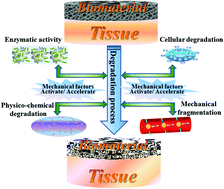Biomechanical studies on biomaterial degradation and co-cultured cells: mechanisms, potential applications, challenges and prospects
Abstract
Biomechanics contains a wide variety of research fields related to biology and mechanics. Actually, to better study or develop a tissue-engineered system, it is now widely recognized that there is no complete nor meaningful study without considering biomechanical factors and the cell response or adaptation to biomechanics. In that respect, this review will focus on not only the influence of biomechanics in biomaterial degradation and co-cultured cells, based on current major frontier research findings, but also the challenges and prospects in biomechanical research. Particularly, through the elaboration of certain typical forces affecting biomaterial degradation and celluar functions, this paper tries to reveal the possible mechanisms, and thus provide ideas on how to design or optimize co-culture systems and apply external forces for proper cell and tissue engineering. Furthermore, while emphasizing the importance of the mechanical control of the cell phenotype and fate, it is expected that these achievements can pave the way to materials-based therapies for different pathological conditions, including diagnosis and treatment of cancer.

- This article is part of the themed collection: Recent Review Articles


 Please wait while we load your content...
Please wait while we load your content...